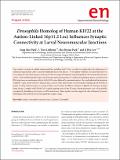| dc.contributor.author | Park, Sang Mee | |
| dc.contributor.author | Littleton, J. Troy | |
| dc.contributor.author | Park, Hae Ryoun | |
| dc.contributor.author | Lee, Ji Hye | |
| dc.date.accessioned | 2017-01-20T18:33:25Z | |
| dc.date.available | 2017-01-20T18:33:25Z | |
| dc.date.issued | 2016-02 | |
| dc.date.submitted | 2016-02 | |
| dc.identifier.issn | 1226-2560 | |
| dc.identifier.issn | 2093-8144 | |
| dc.identifier.uri | http://hdl.handle.net/1721.1/106561 | |
| dc.description.abstract | Copy number variations at multiple chromosomal loci, including 16p11.2, have recently been implicated in the pathogenesis of autism spectrum disorder (ASD), a neurodevelopmental disease that affects 1~3% of children worldwide. The aim of this study was to investigate the roles of human genes at the 16p11.2 loci in synaptic development using Drosophila larval neuromuscular junctions (NMJ), a well-established model synapse with stereotypic innervation patterns. We conducted a preliminary genetic screen based on RNA interference in combination with the GAL4-UAS system, followed by mutational analyses. Our result indicated that disruption of klp68D, a gene closely related to human KIF22, caused ectopic innervations of axon branches forming type III boutons in muscle 13, along with less frequent re-routing of other axon branches. In addition, mutations in klp64D, of which gene product forms Kinesin-2 complex with KLP68D, led to similar targeting errors of type III axons. Mutant phenotypes were at least partially reproduced by knockdown of each gene via RNA interference. Taken together, our data suggest the roles of Kinesin-2 proteins, including KLP68D and KLP64D, in ensuring proper synaptic wiring. | en_US |
| dc.description.sponsorship | Pusan National University (2013 Research Grant) | en_US |
| dc.description.sponsorship | Simons Foundation Autism Research Initiative (Infrastructure Grant Program, 2009) | en_US |
| dc.language.iso | en_US | |
| dc.publisher | Korean Society for Brain and Neural Science (KAMJE) | en_US |
| dc.relation.isversionof | http://dx.doi.org/10.5607/en.2016.25.1.33 | en_US |
| dc.rights | Creative Commons Attribution-NonCommercial 4.0 International | en_US |
| dc.rights.uri | http://creativecommons.org/licenses/by-nc/4.0/ | en_US |
| dc.source | Experimental Neurobiology | en_US |
| dc.title | Drosophila Homolog of Human KIF22 at the Autism-Linked 16p11.2 Loci Influences Synaptic Connectivity at Larval Neuromuscular Junctions | en_US |
| dc.type | Article | en_US |
| dc.identifier.citation | Park, Sang Mee, J. Troy Littleton, Hae Ryoun Park, and Ji Hye Lee. “DrosophilaHomolog of Human KIF22 at the Autism-Linked 16p11.2 Loci Influences Synaptic Connectivity at Larval Neuromuscular Junctions.” Experimental Neurobiology 25, no. 1 (2016): 33. | en_US |
| dc.contributor.department | Massachusetts Institute of Technology. Department of Brain and Cognitive Sciences | en_US |
| dc.contributor.department | Picower Institute for Learning and Memory | en_US |
| dc.contributor.mitauthor | Littleton, J. Troy | |
| dc.contributor.mitauthor | Lee, Ji Hye | |
| dc.relation.journal | Experimental Neurobiology | en_US |
| dc.eprint.version | Final published version | en_US |
| dc.type.uri | http://purl.org/eprint/type/JournalArticle | en_US |
| eprint.status | http://purl.org/eprint/status/PeerReviewed | en_US |
| dspace.orderedauthors | Park, Sang Mee; Littleton, J. Troy; Park, Hae Ryoun; Lee, Ji Hye | en_US |
| dspace.embargo.terms | N | en_US |
| dc.identifier.orcid | https://orcid.org/0000-0001-5576-2887 | |
| mit.license | PUBLISHER_CC | en_US |
| mit.metadata.status | Complete | |
